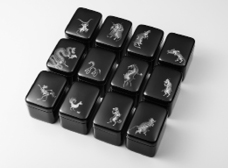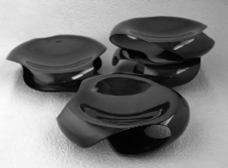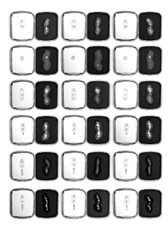Discussion
審査講評(6)
Comments on Honorable Mentions

禁断の果実
Forbidden Fruit
H22×W140×D25
2017

The Animal Carnival
H6×W8×D6
2016

空の皿
Hollow Dish
H5×W18×D18
2017

「花 . 生」
(飾りボタン、ブローチ、箸置き等)
「Peanuts」
(Art Button, Brooch, Chopstick Rest...)
H1.5×W5×D6
2016
Ohnishi ───── Next, a recipient of an Honorable Mention, ‘Forbidden Fruit’ by Mr Keitaro Matsui who lives in Tokyo. Mr Yamamura will comment.
Shinichi Yamamura ───── This work in the Art Category, entitled ‘Forbidden Fruit’ deserves an Honorable Mention. Six different fruits are in the wire frames. Each fruit features motifs from mythology and legends. It is made of Urushi and various other materials and techniques including Raden (mother-of-pearl inlay), Kanshitsu, Makie, kiln cast metals and glass and seashells. The characteristics of these materials are beautifully enhanced in this work.
The mode of display here is very innovative. The height of each of the six frames is subtly adjusted, so that the fruit in the frames can be seen to advantage. Viewed from above, the black Urushi-coated frame is square so that each fruit with its individual characteristics can be easily seen. I see them as forbidden fruit concealed in small boxes of fantasy.
Although the fruit is forbidden, they are so charming and appealing that they do not look poisonous. Urushi techniques are applied to the different parts of each fruit; berries, leaves, and stems. Are the colors the same as those of real fruit? No, they are not. The artist created each fruit based on his own image of its mythology. Such beautiful expressions for the fruit are augmented by the techniques and material.
Each fruit is so dainty that it could be a charm for a pendant. Furthermore, it is set in a wire frame, which is a very effective staging device. Now they are arranged horizontally, but they can be arranged vertically or at random. There must be many ways of arrangement. The owner of this work can arrange each framed fruit as they please according to the space and circumstances of his or her room, for instance horizontally against a wall. I am so curious as to what kind of space this work will be arranged in and I hope I may be able to see its arrangement in the future.
Ohnishi ───── Thank you. Next, ‘The Animal Carnival’ by Mr Evgenii Tselikov from Russia, with an Honorable Mention. Professor Yamamura will comment.
Shinya Yamamura ───── This is the first foreign prize winner at this year’s exhibition. As Professor Ohnishi mentioned at the beginning of the round table discussion, the exhibition received four works from Russia. This is one of the four. At a previous exhibition, a work from Russia was awarded the Kenji Ekuan Prize. This time another Russian artist received an Honorable Mention. I have been very interested and curious in both works from Russia. The previous prize winner was of excellent quality with a Taka-Makie-like technique. This time the artist is an acquaintance of the previous artist.
This work holds a unique view of the world, the likes of which I have never seen. Strictly speaking, the lacquer is not Urushi but another material. One might think that the artist has simply used a varnish to create an Urushi ware-like work. However, to Russian artists it is not Urushi or faux-Urushi. These works are made with local lacquers and traditional techniques.
The artist is a 47-year-old man living near Moscow. I have studied lacquering techniques in Russia and there are about four or five techniques based near Moscow. This artist uses one famous technique called Palekh, which I would really like to study in the near future.
The magnificent point about this work is its quality. Japan’s Urushi ware has a smooth surface or Roiro finish, and the quality of Urushi ware has been highly evaluated. I have no doubt that this artist has developed his techniques to the same level as those of Japan’s Urushi artists. Regarding the material, the groundwork is constructed not with Kanshitsu but with papier-mâché, a kind of solidified paper. By coating the papier-mâché with pigment and varnish, the lacquered work is created.
The artist draws pictures over the groundwork, which, if you look closely, you can see are very detailed. I wonder what kind of ink brush he used, it must have been a slender ink brush equal to Japan’s Nejifude brushes. Unlike the drawings from Japan, he draws the pictures with noticeable fluidity. The pigment used is egg tempera, which he builds up in the slender colored lines of the paintings so that the result may have depth. What is mysterious to me is the luster of the varnish-coated surface, so like a Roiro finish. This luster is thought to come from a newly-finished work, but I do not think so. We have been searching for how to get a Roiro finish from a varnish coating. If the artist comes to Kanazawa, I would really like to ask him to explain the secret.
One more point I would like to talk about is that Japan’s Makie in the past had various traditional patterns, which definitely features a particular view of the world. Japan’s Makie used to have stories, but recently they have become mainly patterned. For example, when I open the lid of a soup bowl, I find another pattern reflecting the pattern on the lid. In the works created by Russian artists, stories are concealed in the paintings. The paintings here are of the twelve signs of the Chinese zodiac, but they are not simply twelve animals. In this story, the mouse is sorry that its year will be over soon, so it mimics the next animal, a cow or an ox, hoping that “one more year should be mine”. That is why the cow mimics the tiger, the tiger mimics the rabbit and so forth. The story continues from one painting to the next, which is quite interesting.
Other works from Russia also feature some stories according to their intention. I hope you will enjoy their works as well when you visit the exhibition. In a way, I think those four works from Russia, so detailed and of excellent quality, are highlights of the works from overseas.
Ohnishi ───── Thank you. The third Honorable Mention recipient is ‘Hollow Dish’ by Mr Yusuke Kudo living in Chiba Prefecture. Mr Motomi Kawakami will talk about it.
Kawakami ───── I hesitate to comment on the technical aspects of the work as I lack the deep understanding of Professor Yamamura. I would assume that this work is by a young artist. It is made of linen cloth Kanshitsu, and I can feel the lightness and the novelty of a dish designed for food arrangement.
The exterior is coated with dark vermillion Tame-nuri and the interior, black Urushi. By hollowing the dish, he could achieve a sense of lightness I haven’t seen in such a work before. When food is arranged on this set of dishes on the table, the guests will enjoy the reflection through the bottom, which provides a new way of enjoying Urushi ware. I appreciate the innovation and I enjoy the boldness of its form. However, at the same time, I feel that the work still has possibilities for development and improvement.
One thing I am concerned about is how to stack the dishes when storing them in a cupboard. In that case, the upper and lower part seem a little too loose and the dishes may develop scratches and blurriness after extended use. Of course the dishes can be re-coated and repaired, but I hope the artist will consider my thoughts and take them into account for future works. In any case, this work is rather challenging and its innovation attracted the jurors’ attention.
Ohnishi ───── Thank you. Next, the fourth Honorable Mention recipient, ‘Peanuts’ (Art Button, Brooch, Chopstick Rest...) by Mr Jianjun Fan, a Chinese exchange student living in Japan. We would like Mr Kaoru Uchino to make comments.
Uchino ───── It was also my first time participating in the Final Assessment. I teach students at the Ishikawa Wajima Lacquer Arts Training Institute, so my everyday life has much to do with ideas of ‘important intangible cultural assets’. However, the conditions of submission for this exhibition is simply ‘something coated with Urushi’. I truly enjoyed looking at these unconstrained works.
This work is entitled ‘Peanuts’. I am afraid a digital image alone cannot show what the work is like. This set is made by coating peanut shells with Urushi and sticking metal fittings to the shells. Each work is so small that they can be put into a 6 x 5 x 1.5cm box. Usually peanuts are of various sizes, so I suppose he used a variety of sizes. He saturates peanut shells in Urushi, stuffs them with Kokuso and other filling materials, covers them with cloth and attaches metal fittings with screws. Each piece is quite strong. The outside is coated with Urushi, sprinkled with gold and silver powders. The work looks simple but it is created with great care. In Wajima similar works have been made using the Chinese lanturn plants. You can also use silicon to create precise forms, such as series of vegetables, strawberries and arrowhead bulbs. This work might stimulate many artists searching for other possibilities. That is why this work received the jurors’ votes.
The artist, Mr Jianjun Fan used to be my student for a year. Although he is big and strong, he also loves paying attention to detail. Three years have passed since he started studying at the Institute. I am impressed by his work, and I look forward to what he will make next year. Although his work has not been fully refined yet, I expect great things from his development. I hope the visitors will enjoy his works.
